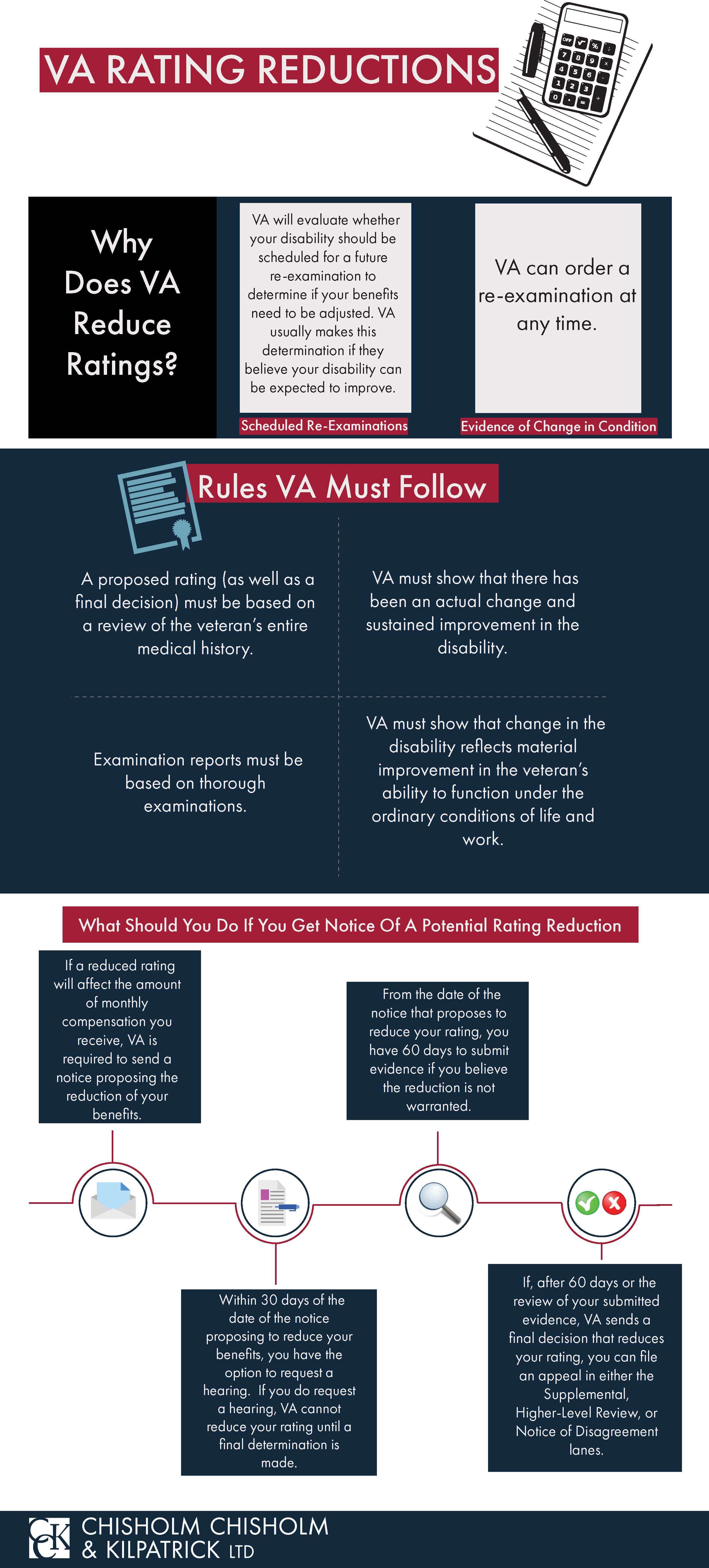When Do VA Ratings Become Permanent?

CCK Law: Our Vital Role in Veterans Law
The VA offers protections for disability ratings that have been in effect for certain periods of time. Until these regulatory protections kick in or your ratings become permanent, VA may sever or reduce a veteran’s disability rating based on specific findings.
When Can the VA Sever Service Connection?
Severance is when the VA tries to revoke a finding of service connection. If the VA tries to sever service connection, it will notify the veteran of the proposed action and give him or her 60 days to submit evidence to show that service connection should not be severed and 30 days to request a hearing. If the veteran does not submit evidence within that 60-day window or request a hearing within 30 days, the VA will issue a final decision.
In cases of severance, veterans are given added protection if they have been service-connected for the condition for 10 years or more. Under 38 C.F.R. 3.957 in the VA code of regulations, a veteran’s service-connected disability that has been in effect for ten years or more “will not be severed except upon a showing that the original grant was based on fraud or it is clearly shown from military records that the person concerned did not have the requisite service or character of discharge.” The ten-year period is calculated from the effective date of the award for service connection. For example, if a veteran was granted service connection for a low back injury effective October 20, 1980 and the VA issued a decision dated August 29, 2018 attempting to sever service connection, the VA would have to abide by the ten-year rule above.
When Can the VA Reduce My Disability Rating?
Veterans with disabilities that are not considered permanent may be sent for future VA examinations in order for the VA to evaluate the severity of those disabilities and rate them appropriately. If the VA finds that a veteran’s condition has improved, it can reduce a veteran’s disability rating.
The VA is required to follow the same process for reductions as they are for severances. This means that if the VA wishes to reduce a disability rating, they must issue notice of the proposed reduction and give the Veteran 60 days to submit evidence and 30 days to request a hearing. However, there is one major difference between the process of a reduction and severance. When the reduction would not change the actual amount of compensation that a veteran is receiving, the VA does not have to issue notice of the reduction.
When Will VA Assign Staged Ratings?
Staged ratings are when the VA changes a disability rating based on the severity of the condition over a period of time. Since claims can take multiple years to be resolved, the VA looks at how the severity of a condition changed during that period of time, and rates the veteran accordingly. Staged ratings can occur when the Veteran’s condition has worsened or bettered from when he or she initially filed the claim, and when the claim was adjudicated.
For example, a veteran filed a claim for an increased rating above 10% for his back condition in 2009. He was then granted an increased rating in 2013, but his back condition progressively worsened throughout those four years. The VA granted him an increase from 10% to 30% from 2009 to 2011 based on the severity during that period, and they then granted him 40% from 2011 forward.
When Does My VA Rating Become Permanent?
An easy way to tell if your VA disability ratings are permanent is if the VA has deemed you to be totally and permanently disabled. This means that the VA does not see a reasonable chance of your conditions improving. However, if you are not “permanent and total,” the VA has regulatory protections for reductions of service-connected disabilities.
Under 38 C.F.R. 3.951 (b), the VA cannot reduce a rating that has been “continuously rated at or above any evaluation of disability for 20 or more years” unless it is shown that the rating was based on fraud. So, for example, if you are rated at 20% for a right knee disability from January 1994 and the VA proposes to reduce your right knee rating to 0% in March 2017, they can only do so if they find that your initial 20% rating was based on fraud. If they cannot show that, they cannot reduce your 20% rating. This rule protects disabilities that have been increased over the span of 20 years or more as well. For example, the veteran who receives 20% for his right knee disability from January 1994 was increased to 30% in 2006. In March 2017, the VA proposes to reduce his 30% to 0%. Although the rating for the right knee condition changed between the initial grant and the proposed reduction, he is still protected under the 20-year rule.
Stabilized Ratings
Stabilized ratings are for conditions that have been continuously rated for 5 years or more at the same disability level. In order for the VA to reduce stabilized ratings, they must show that your condition has exhibited sustained improvement. The threshold of evidence is higher in this circumstance as VA cannot rely on only one C&P examination to implement the reduction of a stabilized rating.
When Does My VA Rating Become Total?
Veterans’ disabilities are rated based on VA’s Schedule of Rating Disabilities. The ratings levels for each type of disability are based on the severity of your symptomatology and the level of social and occupation impairment that you experience as a result. A 100% rating indicates that your disability is completely, or “totally,” disabling. 100% total ratings may be reduced if the VA can show that your condition has shown material improvement. Material improvement means that there has been a significant change in the veteran’s ability to function in daily life.
Temporary Total Ratings
VA allows veterans to be compensated at the 100% rate during a hospitalization in excess of 21 days due to a service-connected condition, and for the period following the hospitalization. The VA calls these “convalescent ratings.”Convalescent ratings can span for up to three months following hospital discharge or release from outpatient treatment. Veterans can apply for convalescent ratings longer than those three months, but VA decides those claims on a case-by-case basis.
Following a temporary total evaluation, VA will rate the Veteran’s condition based on the new level of severity. VA will assess the new level of severity based on medical records from the period of convalescence. However, if VA is unable to adequately assess severity from the records, the veteran will be scheduled for an exam to assign the appropriate rating.
What If I Have TDIU? Is TDIU Permanent?
For Veterans that have been granted entitlement to Total Disability Based on Individual Unemployability (“TDIU”), the VA can only reduce that rating if “actual employability is established by clear and convincing evidence” (38 C.F.R. 3.3.43(c)). What that means is the VA can only sever your TDIU if you have been found to be employable. For veterans with TDIU, the VA will send out a yearly employment questionnaire to see if a veteran participated in substantially gainful employment during that year. In order for the employment to be substantially gainful, a veteran would have had to be employed for 12 months or more and would have had to earn over the federal poverty threshold.
Check out our video on Permanent and Total disability HERE.
Were your VA benefits reduced or severed improperly? We may be able to help.
If you think that your rating was reduced or severed improperly by the VA, we may be able to help. Contact our office for a free consultation at (800) 544-9144.
About the Author
Share this Post

